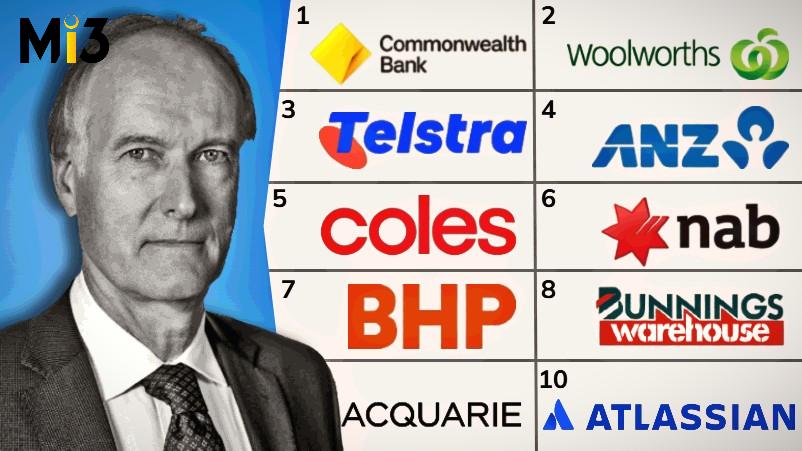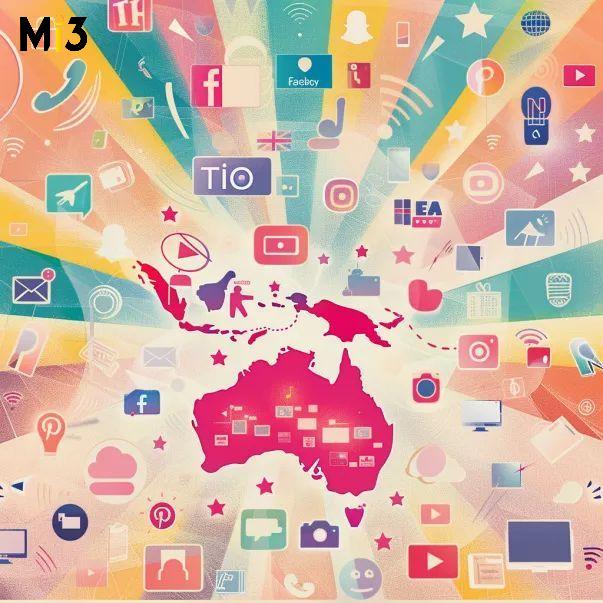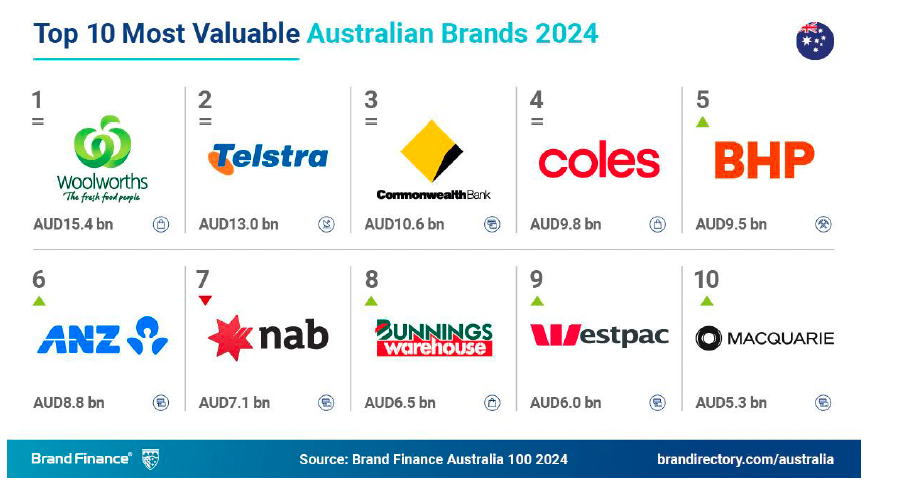Reputation hits overcooked: Supermarket gouging pressure won’t see shoppers switch, says Brand Finance chief – but Commbank flips Woolworths as Australia’s most valuable brand at $15.7bn

What you need to know:
- Australia’s two big food retailers are the latest brands to feel the heat of reputational damage. But corporate affairs and marketing chiefs may be oversensitive given consumer – and revenue – impacts will be minimal.
- Brand Finance chief Mark Crowe says crises can be managed and will only do damage if sustained – though upstream impacts, i.e. loss of government, media and regulatory influence could ultimately impact the P&L.
- Either way, Woolworths’ and Coles’ brand values have both declined, per Brand Finance’s latest rankings, with Commbank rising the wave to the top via a near 50 per cent brand value surge.
- Telco brand values have also dropped. While Vodafone tanked disproportionately, the broader category shrinkage is largely due to economic pressures, per Crowe.
- Hence he warns marketing KPIs based on brand value should be treated with caution.
The biggest driver of consideration in retail continues to be physical availability – location – and to what extent people are prepared to translate their negative perceptions into driving a further 5k down the road to an alternative. Our study suggests you're not seeing that in big numbers.
The consumer impact of corporate crises and reputational fallout on brands and their bottom lines is overcooked, according to the latest financial evaluation of Australia’s top brands.
While food retailers – notably Woolworths and Coles – are mired in political strife and masthead crosshairs over price gouging amid squeezed household budgets, Brand Finance MD, Mark Crowe suggests it will have minimal impact of consumer behaviour.
Both supermarkets dropped places on Brand Finance’s annual rankings, used by finance chiefs to gauge brand’s economic contribution – and increasingly in M&A discussions – with Commbank the beneficiary. The bank leapfrogged Woolworths as Australia’s most valuable brand for the first time in five years following a 48 per cent value surge to $15.7bn. Woolworths fell 17 per cent to $12.7, Coles 14 per cent to $8.4bn.
“Commbank is the star performer, but Coles and Woolworths have dropped significantly in brand value – the biggest drops they’ve experienced in years,” Crowe told Mi3.
Brand value (with brands ranked in the tables below) is a calculation of the economic benefits a brand brings to a business. Brand Finance also measures brand strength, which factors in investment in the brand, the equity the brand holds, and financial performance. The firm suggests brand strength is key indicator of future brand value and through it, stronger returns.
Impact overcooked?
Much of the retail sector’s declining brand value relates to financial forecasts, guidance and ongoing impacts of pressured consumer spending. But for the big two supermarkets, sustained negative headlines and government inquiries are a key factor.
Crowe however suggests the effects won’t be felt at the tills – because Australia, despite Aldi’s incursions, remains a duopoly.
“There’s no doubt those reputational issues have impacted both Coles and Woolworths. But the interesting thing is, the reputational damage to the extent that it starts to impact on the business can be limited by people’s perceptions – and to what extent negative perceptions translate into actual changes in behaviour, in people switching [to another retailer as a result]?”
Per Crowe: “The biggest driver of consideration in retail continues to be physical availability – location – and to what extent people are prepared to translate their negative perceptions into driving a further 5k down the road to an alternative.
“Our brand equity study would suggest you’re not seeing that in big numbers.”
When you look at the retailers and airlines, where reputational damage has really impacted them is that their government relations and their media relations are poorer for it, and the ability of those businesses to influence government decisions is dramatically reduced. That's going to have a real cost impact. Ultimately a revenue impact as well.
Top 50 Australian brand valuations:

Australia's top 50 brands ranked by brand value. Source: Brand Finance
Hidden costs
However, Crowe warned not all categories were as crisis resilient – and that sustained reputation beatings ultimately take their toll, citing Optus and Qantas as key examples.
“Reputational damage is very manageable for a strong brand in the short-term – and where some businesses are going through reputational challenges, they’re not necessarily seeing that convert into drops in changes in revenues and customer,” said Crowe.
“But if that lingers and it becomes systemic, that’s where it’s going to eventually lead to changing customer behaviour.”
Upstream impacts also carry financial penalties.
“When you look at the retailers and airlines, where reputational damage has really impacted them is that their government relations and their media relations are poorer for it, and the ability of those businesses to influence government decisions is dramatically reduced,” said Crowe.
“That’s going to have a real cost impact upon them. Ultimately that can have a revenue impact as well.”
Qantas’ brand value has recovered significantly (+$1bn to $3.8bn) following two years of decline stemming from fallout over selling tickets for cancelled flights, accusations of price gouging and customer service fails. But Crowe said there was “no doubt” the airline’s ability to influence government decisions on rival carrier allocations “has been negatively affected”.
Telco disconnect
Optus’ brand value is still suffering the effects of its 2022 data breach and 2023 outage. It declined by a further $600m dollars, circa 15 per cent year on year, per Brand Finance’s numbers.
“Optus has an unfortunate situation. They’ve had two years where their brand strength has dropped considerably – at one point [in 2019] they were second strongest brand in Australia.”
But Crowe underlined that the collective brand value of the entire telco sector has declined year on year.
Per Brand Finance’s calculations, Vodafone’s brand value plummeted by around a third to $449m while Telstra also dropped 7 per cent, or $900m to $12.1bn. Crowe said Telstra’s was a good result, with the value decline primarily due to economic conditions. “They’ve been investing – and their brand strength is up.”
Brand value can be up purely due to favourable market conditions. Likewise it can be down due to unfavourable conditions. If you’re marking [i.e. KPI-ing] the CMO, you need to look to what extent factors are controllable by them.
Kmart winning
Economic headwinds have proved a boon per Kmart’s ranking. Its brand value soared 66 per cent to $3.2bn.
“They are experiencing significant growth, with market positioning that taps into cost of living issues and Kmart’s sub-brand Anko is certainly one to watch,” said Crowe.
“Frankly, we will consider looking at Anko [as a standalone brand] in the future because it is now such a big brand in Australia. Kmart in retail is a true success story.”
Tech vs media
Brand Finance rankings of the world’s most valuable brands is dominated by tech firms, though it classifies many of those platforms – Google, Facebook and Tiktok – as media businesses.
Australia has one tech firm, Atlassian, within the top 10 on the back of a 23 per cent rise in revenue, strong customer growth and product innovation. But Australia lacks the scale to sustain similar unicorns, and Crowe suggests the brand value top order locally is unlikely to follow the global trend.
“You can say with some certainty you won’t see many new [tech] entrants in the top 10 any time soon.”
Beer cheer
Beer brands also increased brand value year on year, notably XXXX and Tooheys – both more than doubling.
Crowe called out the latter for driving growth through strategic marketing and product innovation, refreshing its image via no and low alcohol brews.
Australia’s Top 50 Brand Valuations:
KPI bonus?
While Crowe said some marketers locally and internationally have brand strength and value as part of key performance indicators, including the latter with KPIs is risky.
“You need to understand what has driven the change. Brand value can be up purely due to favourable market conditions. Likewise it can be down due to unfavourable conditions.
“If you’re marking the CMO, you need to look to what extent factors are controllable by them – which is essentially brand strength and brand equity,” said Crowe.
“You can come up with figure, but you really need to know what’s driving that figure.”
Top 20 global brand valuations

Above: Global top 20 brands ranked by brand value. Source: Brand Finance





